Kansas Duck Hunting: A Comprehensive Overview
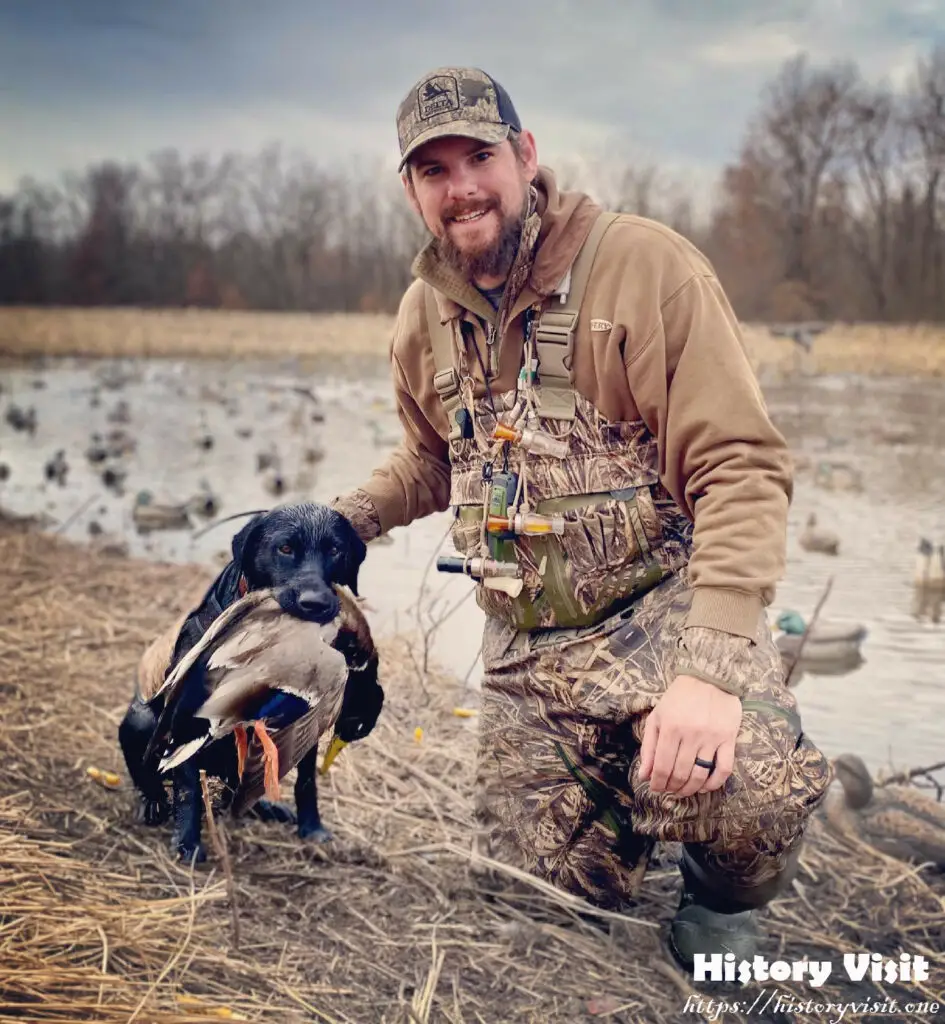
Brief introduction to Kansas as a hunting destination.
Kansas is renowned as a premier hunting destination, offering diverse landscapes and abundant wildlife that attract hunters from across the nation. Known for its vast prairies, wetlands, and rich agricultural fields, Kansas provides ideal habitats for a wide range of game, including ducks, pheasants, deer, and turkeys. The state’s commitment to conservation and sustainable hunting practices ensures robust wildlife populations and a high-quality hunting experience. Whether you are a seasoned hunter or a beginner, Kansas’ combination of excellent public hunting lands, varied terrains, and rich hunting heritage makes it a top choice for outdoor enthusiasts.
Importance of duck hunting in Kansas.
Duck hunting holds significant importance in Kansas, both culturally and economically. The state’s extensive wetlands and water bodies serve as crucial stopover points for migratory ducks, making Kansas a prime location for waterfowl hunting. This activity is deeply embedded in the local heritage, fostering a strong community of hunters who pass down traditions through generations.
Economically, duck hunting contributes to the local economy by generating revenue through hunting licenses, equipment sales, and tourism. Additionally, the funds collected from hunting permits and stamps are reinvested into conservation efforts, helping to preserve and enhance wetlands and wildlife habitats. These efforts ensure the sustainability of duck populations and the overall health of Kansas’ ecosystems.
Duck hunting also promotes outdoor recreation and wildlife appreciation, encouraging people to engage with and respect nature. By participating in regulated hunting, hunters play a pivotal role in wildlife management, helping to maintain balanced ecosystems and control duck populations. Overall, duck hunting in Kansas is a vital aspect of the state’s natural and cultural landscape, supporting both ecological conservation and the local economy.
History of duck hunting in Kansas.
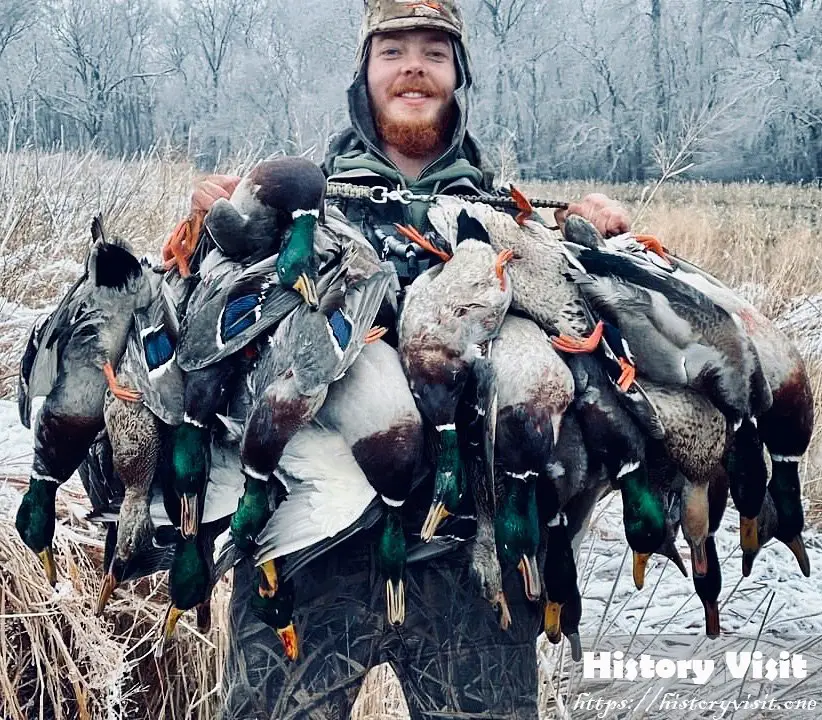
Early Beginnings
The history of duck hunting in Kansas dates back to the 19th century, when early settlers and Native American tribes relied on hunting as a crucial source of food and materials. The vast wetlands, rivers, and prairies of Kansas provided an ideal habitat for a variety of waterfowl, making the region a prime hunting ground. As settlers established farms and communities, hunting practices began to evolve, integrating traditional knowledge with new techniques.
Development of Regulations
By the early 20th century, the impact of unregulated hunting and habitat loss led to a noticeable decline in duck populations. In response, conservationists and hunters advocated for regulations to manage and protect waterfowl resources. The Migratory Bird Treaty Act of 1918 marked a significant milestone, establishing federal protection for migratory birds and setting the foundation for future conservation efforts.
Kansas adopted state-specific regulations to complement federal laws, focusing on sustainable hunting practices and habitat preservation. The establishment of hunting seasons, bag limits, and the requirement of hunting licenses helped to ensure that duck populations remained healthy and that hunting could continue for future generations.
Growth of Conservation Efforts
The mid-20th century saw a growing awareness of the importance of wetlands and other critical habitats for waterfowl. Organizations such as Ducks Unlimited played a pivotal role in promoting conservation projects across Kansas. Efforts to restore and protect wetlands, such as Cheyenne Bottoms and Quivira National Wildlife Refuge, became central to maintaining robust duck populations.
Modern Era and Current Practices
Today, duck hunting in Kansas is characterized by a balance between tradition and modern conservation practices. Advances in equipment, techniques, and regulations have made hunting more efficient and sustainable. The Kansas Department of Wildlife, Parks, and Tourism (KDWPT) continues to manage hunting seasons, monitor duck populations, and enforce regulations to ensure ethical and responsible hunting.
Hunters in Kansas are also active participants in conservation efforts, contributing through hunting fees and volunteering for habitat restoration projects. Educational programs and hunter safety courses further emphasize the importance of ethical hunting and wildlife management.
Evolution of regulations and conservation efforts.
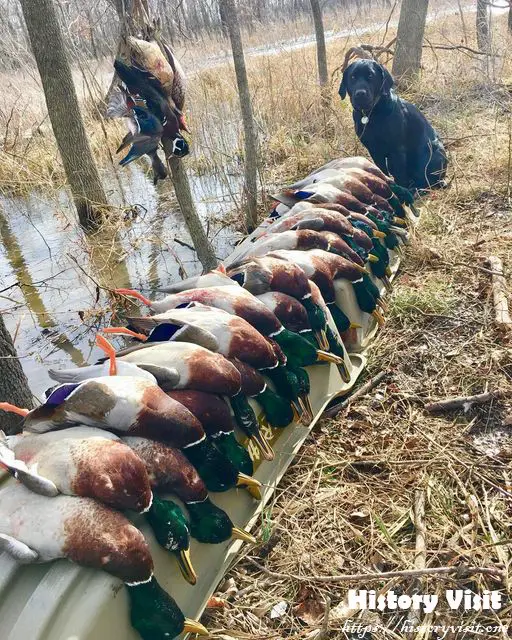
Early Regulation and Awareness
The unregulated hunting of the 19th and early 20th centuries led to significant declines in duck populations across Kansas. Recognizing the need for sustainable practices, early conservationists and hunters began advocating for regulatory measures. The pivotal moment came with the Migratory Bird Treaty Act of 1918, which provided federal protection for migratory birds and established foundational guidelines for waterfowl management.
Establishment of State Regulations
Following the federal lead, Kansas developed state-specific regulations aimed at ensuring sustainable hunting practices:
- Hunting Seasons: Kansas established specific hunting seasons for ducks to prevent overhunting during critical breeding and migration periods.
- Bag Limits: Imposing daily and possession limits helped control the number of ducks harvested, ensuring that populations could replenish.
- Licensing: The requirement for hunters to obtain licenses and permits ensured that only qualified individuals could hunt, and the fees generated provided funds for conservation efforts.
Expansion of Conservation Efforts
As the 20th century progressed, the focus on habitat conservation became increasingly important. Key developments included:
- Wetland Restoration and Protection: Recognizing the crucial role of wetlands in supporting waterfowl, Kansas undertook significant projects to restore and protect these habitats. The Cheyenne Bottoms and Quivira National Wildlife Refuge became focal points for these efforts.
- Partnerships with Organizations: Collaborations with organizations like Ducks Unlimited and the Kansas Wildlife Federation enhanced conservation initiatives. These partnerships brought additional resources and expertise to habitat preservation projects.
Modern Regulations and Technological Advancements
With the advent of modern technology and better scientific understanding, Kansas further refined its approach to duck hunting regulations and conservation:
- Monitoring and Research: Advanced monitoring techniques, including aerial surveys and satellite tracking, provide detailed data on duck populations and migratory patterns. This data informs more precise and adaptive management strategies.
- Adaptive Management: Regulations are regularly reviewed and adjusted based on the latest scientific research and population data. This ensures that hunting practices remain sustainable and responsive to changing environmental conditions.
Education and Community Involvement
Education and community involvement have become integral components of conservation efforts:
- Hunter Education Programs: Mandatory hunter education courses teach safe and ethical hunting practices, conservation principles, and wildlife management. These programs are crucial for fostering responsible hunting communities.
- Public Awareness Campaigns: Efforts to raise public awareness about the importance of wetlands and waterfowl conservation help garner broader support for environmental initiatives.
- Volunteer Opportunities: Hunters and community members are encouraged to participate in habitat restoration projects and other conservation activities, fostering a sense of stewardship and shared responsibility.
Current and Future Challenges
While significant progress has been made, ongoing challenges such as climate change, habitat loss, and increasing human encroachment require continuous attention. Future conservation efforts will likely focus on:
- Climate Resilience: Developing strategies to mitigate the impacts of climate change on waterfowl habitats.
- Sustainable Agriculture Practices: Collaborating with farmers to promote practices that benefit both agriculture and wildlife conservation.
- Innovative Funding Mechanisms: Exploring new funding sources for conservation projects, including public-private partnerships and grant programs.
Major Duck Hunting Areas in Kansas
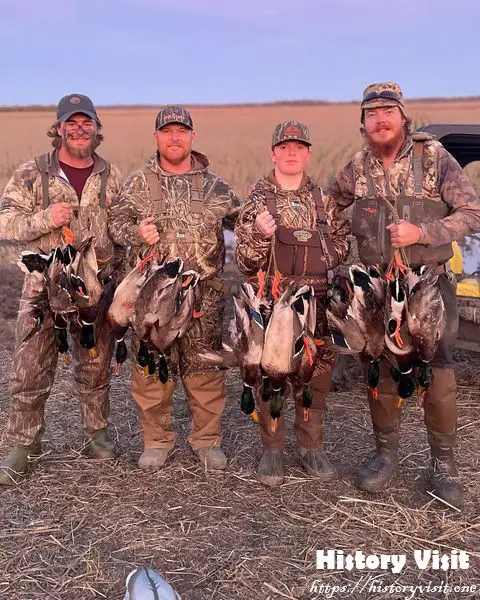
Kansas boasts several prime locations for duck hunting, each offering unique habitats and abundant waterfowl populations. Here are some of the top duck hunting areas in the state:
1. Cheyenne Bottoms Wildlife Area
- Location: Central Kansas, near Great Bend.
- Description: Cheyenne Bottoms is the largest inland marsh in the United States, spanning over 41,000 acres. It is a critical stopover for migratory birds on the Central Flyway.
- Habitat: The area features extensive wetlands, shallow marshes, and open water, creating ideal conditions for a variety of duck species.
- Species: Commonly hunted ducks include Mallards, Northern Pintails, and Gadwalls.
- Facilities: Public hunting areas with designated blinds and access points. The area is managed by the Kansas Department of Wildlife, Parks, and Tourism (KDWPT).
2. Quivira National Wildlife Refuge
- Location: South-central Kansas, near Stafford.
- Description: Covering over 22,000 acres, Quivira National Wildlife Refuge is renowned for its diverse bird populations and wetland habitats.
- Habitat: The refuge includes salt marshes, freshwater wetlands, and prairie uplands, supporting a wide range of waterfowl.
- Species: Notable species include Mallards, Blue-winged Teal, and Northern Shovelers.
- Facilities: Designated hunting areas, with regulations to ensure sustainable use and conservation of wildlife.
3. Neosho Wildlife Area
- Location: Southeastern Kansas, near St. Paul.
- Description: The Neosho Wildlife Area spans approximately 3,246 acres and is known for its managed wetland units and abundant waterfowl.
- Habitat: The area features a mix of wetlands, ponds, and flooded timber, providing excellent duck hunting opportunities.
- Species: Hunters frequently encounter Mallards, Wood Ducks, and Teal.
- Facilities: Public hunting areas with maintained blinds and boat ramps. The area is managed to enhance waterfowl habitat and hunting success.
4. Marais des Cygnes Wildlife Area
- Location: Eastern Kansas, near Pleasanton.
- Description: This wildlife area encompasses over 7,600 acres, with a mix of wetlands, woodlands, and prairies.
- Habitat: Extensive wetland restoration projects have created prime waterfowl habitats.
- Species: Common species include Mallards, Northern Pintails, and Green-winged Teal.
- Facilities: Multiple access points for hunters, with areas designated for waterfowl hunting. Managed by KDWPT to support wildlife conservation and public recreation.
5. Jamestown Wildlife Area
- Location: North-central Kansas, near Jamestown.
- Description: Covering around 3,500 acres, Jamestown Wildlife Area is known for its diverse habitats and significant waterfowl populations.
- Habitat: The area includes marshes, ponds, and agricultural fields, providing varied environments for ducks.
- Species: Mallards, Northern Pintails, and Canvasbacks are commonly hunted here.
- Facilities: Public hunting areas with boat ramps and maintained access routes. The area is actively managed to optimize waterfowl habitat and hunting conditions.
6. Tuttle Creek Wildlife Area
- Location: Northeastern Kansas, near Manhattan.
- Description: Tuttle Creek Wildlife Area spans over 12,000 acres, offering a variety of habitats for waterfowl and other wildlife.
- Habitat: The area features wetlands, riverine environments, and agricultural lands.
- Species: Popular species include Mallards, Gadwalls, and Teal.
- Facilities: Designated hunting zones with blinds and boat access. Managed to balance recreational use and wildlife conservation.
Overview of Habitats and Their Significance in Kansas Duck Hunting

Kansas is renowned for its diverse and productive habitats, which are crucial for supporting waterfowl populations. The state’s wetlands, marshes, rivers, and prairies provide essential resources for ducks during their migration and breeding seasons. Here’s an overview of the key habitats and their significance:
1. Wetlands
- Description: Wetlands are areas where water covers the soil or is present near the surface for parts of the year. These can be marshes, swamps, or bogs.
- Significance: Wetlands are the most important habitats for waterfowl in Kansas. They provide food, shelter, and breeding grounds for ducks. Wetlands support a diverse array of plant and animal life, creating a rich ecosystem.
- Examples: Cheyenne Bottoms, Quivira National Wildlife Refuge.
2. Marshes
- Description: Marshes are a type of wetland characterized by herbaceous plants rather than woody plants. They can be freshwater or saltwater and are often found at the edges of lakes and rivers.
- Significance: Marshes offer abundant food sources such as aquatic plants, insects, and small fish, which are crucial for ducks, especially during migration. They also provide nesting sites and protection from predators.
- Examples: Jamestown Wildlife Area, Neosho Wildlife Area.
3. Rivers and Streams
- Description: Rivers and streams are flowing bodies of water that move continuously in one direction. They are important corridors for wildlife movement and habitat connectivity.
- Significance: Rivers and streams provide feeding and resting areas for migratory ducks. The riparian zones along these waterways offer shelter and nesting sites, as well as access to food.
- Examples: Marais des Cygnes River, Kansas River.
4. Lakes and Reservoirs
- Description: Lakes and reservoirs are large bodies of standing water. Reservoirs are typically man-made, created by damming rivers for water storage and management.
- Significance: These water bodies serve as major resting and feeding areas for ducks during migration. They often support large congregations of waterfowl, providing hunters with excellent opportunities.
- Examples: Tuttle Creek Lake, Milford Lake.
5. Prairies and Grasslands
- Description: Prairies and grasslands are ecosystems dominated by grasses and other herbaceous plants, with few or no trees.
- Significance: While not primary duck habitats, prairies and grasslands are important for maintaining overall biodiversity. They support a range of wildlife and provide nesting sites for some duck species. They also play a role in water quality by filtering runoff before it reaches wetlands and rivers.
- Examples: Flint Hills, Smoky Hills.
6. Flooded Timber and Agricultural Fields
- Description: Flooded timber areas are forests inundated with water, while agricultural fields can become temporary wetlands during certain seasons or through intentional flooding.
- Significance: Flooded timber provides unique hunting environments and crucial habitat for ducks, offering food and cover. Agricultural fields, especially when flooded, create additional feeding opportunities, attracting large numbers of ducks.
- Examples: Areas within Neosho Wildlife Area, managed agricultural fields in various wildlife areas.
Overview of Hunting Seasons for Different Duck Species in Kansas
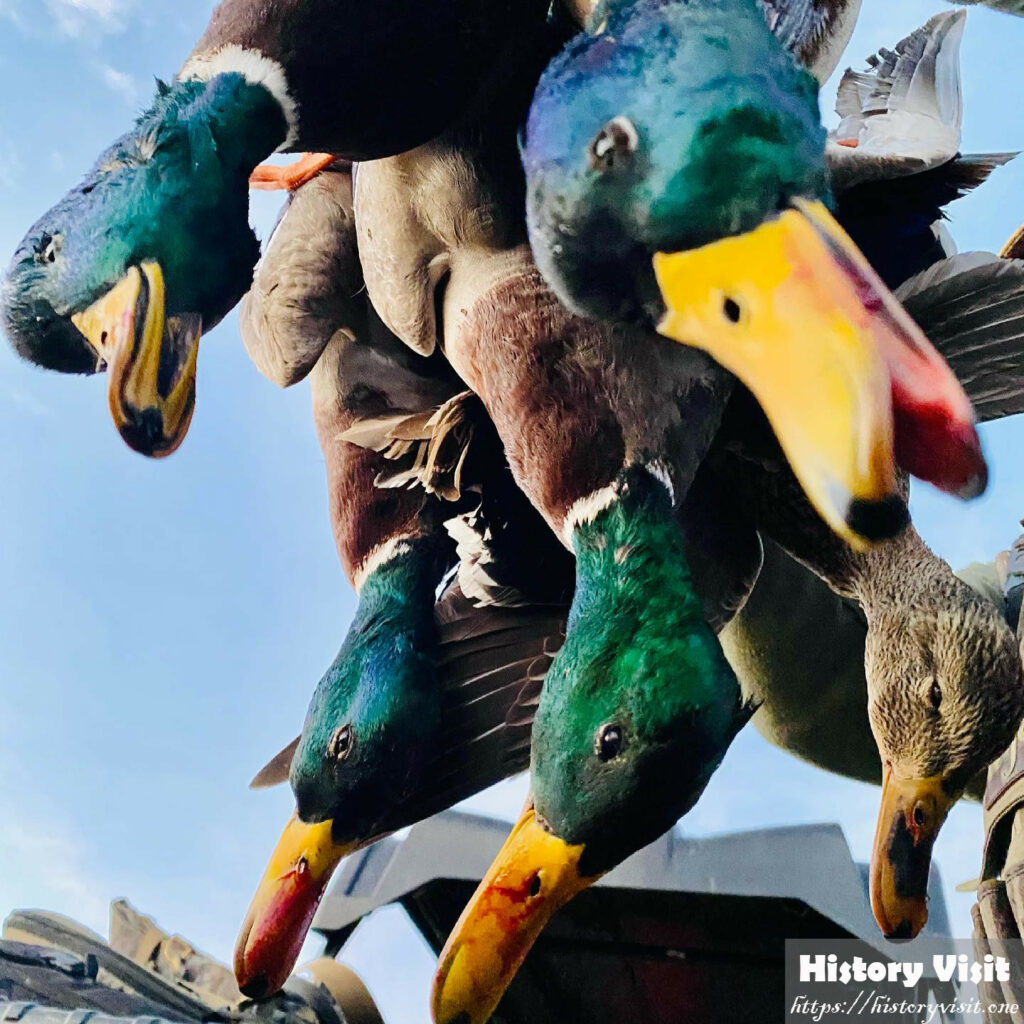
Kansas offers a variety of hunting seasons for different duck species, carefully regulated to ensure sustainable waterfowl populations and align with the migratory patterns of the birds. The Kansas Department of Wildlife, Parks, and Tourism (KDWPT) sets these seasons based on extensive research and population monitoring. Here’s an overview of the hunting seasons for some of the most common duck species in Kansas:
1. Mallards
- Season: Typically, the general duck hunting season includes Mallards and spans from late October to late January.
- Details: Mallards are one of the most sought-after species in Kansas. They are abundant and can be found in various habitats, including wetlands, rivers, and lakes.
2. Northern Pintails
- Season: Pintails are included in the general duck hunting season, which generally runs from late October to late January.
- Details: Northern Pintails are early migrants and often arrive in Kansas in large numbers. Hunters should be aware of specific bag limits for pintails, as they can differ from other species.
3. Gadwalls
- Season: The general duck hunting season, from late October to late January, covers Gadwalls.
- Details: Gadwalls are commonly found in marshes and wetlands. They are known for their distinctive flight patterns and are a popular target for hunters.
4. Blue-winged Teal
- Season: Blue-winged Teal have a special early teal season in addition to being included in the general duck season. The early teal season usually occurs in September.
- Details: Blue-winged Teal are early migrants, often moving through Kansas before many other species. The early teal season provides hunters an opportunity to target these birds specifically.
5. Green-winged Teal
- Season: Included in both the early teal season (September) and the general duck hunting season (late October to late January).
- Details: Green-winged Teal are smaller ducks that migrate later than Blue-winged Teal but are still prevalent during the general season.
6. Northern Shovelers
- Season: Part of the general duck hunting season from late October to late January.
- Details: Northern Shovelers, with their distinctive spoon-shaped bills, are commonly found in shallow wetlands and are a frequent target during the season.
7. Wood Ducks
- Season: Included in the general duck hunting season from late October to late January.
- Details: Wood Ducks prefer wooded swamps and flooded timber areas. They are known for their striking plumage and are a prized species among hunters.
8. Canvasbacks and Redheads
- Season: These species are part of the general duck hunting season from late October to late January.
- Details: Canvasbacks and Redheads are diving ducks often found in larger bodies of water. They may have specific daily bag limits that hunters need to adhere to.
Special Seasons and Regulations

- Youth and Veteran Hunting Days: Kansas typically designates special hunting days for youth and veterans before the general season opens. These days allow young hunters and veterans exclusive access to hunting areas, providing a unique opportunity to hunt with less competition.
- Daily Bag Limits: Each species has specific bag limits set by KDWPT to ensure sustainable hunting. Hunters must be familiar with these limits, which can vary from year to year based on population assessments.
Licensing Requirements and Regulations for Duck Hunting in Kansas
To participate in duck hunting in Kansas, hunters must comply with a series of licensing requirements and regulations designed to ensure sustainable hunting practices and wildlife conservation. Here is an overview of the necessary licenses, permits, and key regulations:
Licensing Requirements
- Kansas Hunting License
- Residents: All Kansas residents aged 16 to 74 are required to purchase a hunting license. Exemptions apply to landowners hunting on their own land, youth under 16, and seniors 75 and older.
- Non-Residents: All non-resident hunters, regardless of age, must purchase a non-resident hunting license.
- Federal Migratory Bird Hunting and Conservation Stamp (Duck Stamp)
- Required for all hunters aged 16 and older. This stamp is valid nationwide and helps fund wetland conservation efforts.
- Kansas State Waterfowl Permit
- Required for hunters aged 16 and older who hunt ducks, geese, or other migratory birds in Kansas.
- Harvest Information Program (HIP) Registration
- All migratory bird hunters must register with the HIP, which involves providing information on previous hunting activities. This registration helps track and manage bird populations.
Additional Permits
- Special Hunts
- Kansas offers special hunting opportunities through drawings and permits. Hunters may need to apply in advance for these hunts, which can provide access to specific areas or dates not available in the general season.
Key Regulations
- Hunting Seasons and Bag Limits
- Hunters must adhere to established hunting seasons and daily bag limits for each species. These limits are set annually based on population surveys and are critical for maintaining sustainable waterfowl populations.
- Shooting Hours
- Legal shooting hours for waterfowl hunting in Kansas are from one-half hour before sunrise to sunset. Precise times are published annually and vary slightly throughout the season.
- Methods of Take
- Hunters may use shotguns only. The use of rifles, pistols, or other firearms is prohibited for waterfowl hunting.
- Non-toxic shot is mandatory for all waterfowl hunting. Lead shot is not allowed due to its harmful environmental impacts.
- Possession Limits
- Hunters must comply with possession limits, which generally restrict the number of ducks a hunter can have in their possession at any time to three times the daily bag limit.
- Identification of Birds
- Hunters must maintain species identification of ducks in the field and during transportation until they reach their final destination. This usually means leaving a wing or head attached to the bird.
- Hunting Ethics and Safety
- Hunters must follow all safety guidelines, including wearing blaze orange during upland game bird hunting seasons.
- Respect for private property, other hunters, and the environment is paramount. Ethical hunting practices are encouraged to ensure a positive experience for all.
- Hunter Education
- All hunters born on or after July 1, 1957, must complete a certified hunter education course before purchasing a hunting license. This course covers firearm safety, hunting ethics, and wildlife conservation.
- Reporting Requirements
- Hunters may be required to report their harvests to aid in wildlife management efforts. Specific instructions are provided annually by the KDWPT.
Conservation and Ethical Hunting Practices in Kansas

Conservation and ethical hunting practices are fundamental principles that guide duck hunting in Kansas. Hunters play a vital role in preserving wildlife populations and their habitats while ensuring a sustainable hunting tradition for future generations. Here are some key conservation and ethical practices:
Conservation Practices
- Habitat Preservation and Restoration
- Support conservation efforts aimed at preserving and restoring wetlands, marshes, and other critical habitats for waterfowl. Get involved in habitat restoration projects and volunteer with organizations dedicated to conservation.
- Wetland Management
- Promote responsible wetland management practices to maintain healthy ecosystems that support waterfowl populations. Support initiatives that protect wetlands from drainage, pollution, and other forms of degradation.
- Responsible Land Use
- Advocate for responsible land use practices that minimize habitat destruction and fragmentation. Encourage sustainable agriculture and development practices that prioritize wildlife habitat conservation.
- Invasive Species Control
- Participate in efforts to control invasive species that threaten native habitats and waterfowl populations. Support programs aimed at eradicating invasive plants and animals from wetlands and other critical areas.
- Public Education and Outreach
- Educate others about the importance of conservation and wildlife stewardship. Raise awareness about the value of wetlands, biodiversity, and the role of hunters in wildlife management.
Ethical Hunting Practices
- Respect for Wildlife
- Treat wildlife with respect and empathy. Follow fair chase principles and avoid unnecessary suffering to animals. Make ethical shot selections to ensure clean kills and minimize wounded animals.
- Compliance with Regulations
- Know and adhere to all hunting regulations, including bag limits, shooting hours, and species identification requirements. Report harvests as required by law and support enforcement efforts to combat illegal hunting practices.
- Firearm Safety
- Practice safe firearm handling at all times. Treat every firearm as if it were loaded, and never point it at anything you do not intend to shoot. Always keep the muzzle pointed in a safe direction.
- Environmental Stewardship
- Minimize your environmental impact while hunting. Pack out all trash and debris, and avoid disturbing sensitive habitats and wildlife. Respect private property and obtain permission before entering or hunting on private lands.
- Hunter Education and Mentorship
- Continuously improve your hunting skills and knowledge through education and training. Mentor new hunters and share your passion for ethical hunting practices and conservation values.
- Fair Chase
- Embrace the principles of fair chase, which emphasize the pursuit of game under conditions that give animals a reasonable chance to escape. Avoid using unfair advantages that compromise the integrity of the hunt.
- Gratitude and Respect
- Approach hunting with gratitude for the opportunity to connect with nature and harvest food sustainably. Respect the animals you hunt and honor their sacrifice by utilizing harvested game responsibly.
Common species hunted in Kansas (e.g., Mallard, Northe)
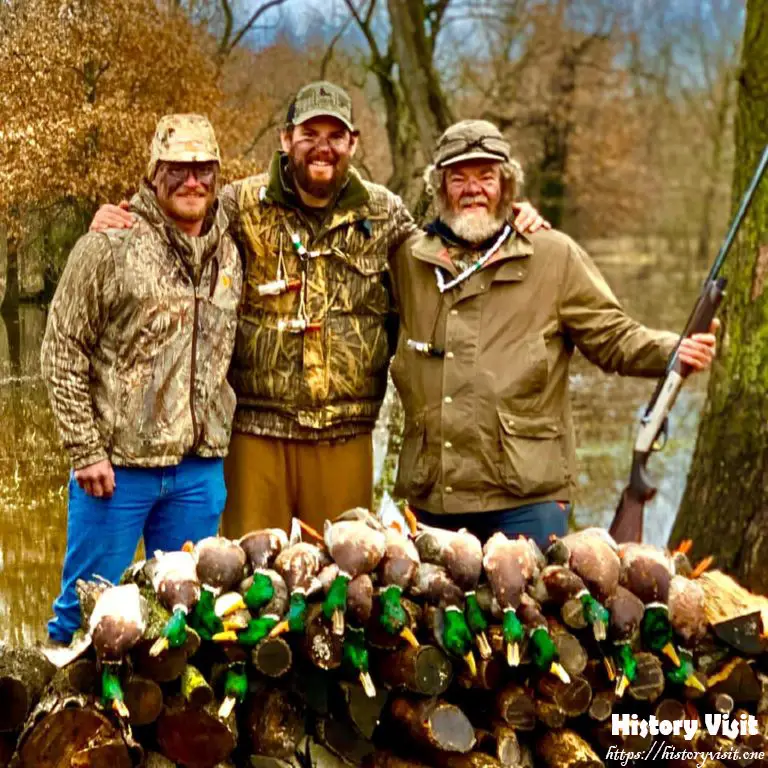
In Kansas, hunters commonly pursue a variety of waterfowl species, each presenting unique challenges and opportunities. Here are some of the most common species hunted in Kansas:
1. Mallard (Anas platyrhynchos)
- Description: Mallards are the most recognizable and abundant duck species in North America. Males have striking green heads, white neck rings, and chestnut-brown chests, while females are mottled brown.
- Habitat: Mallards inhabit a wide range of wetland habitats, including marshes, ponds, rivers, and agricultural fields.
- Significance: Mallards are highly prized by hunters for their abundance, versatility, and delicious meat.
2. Northern Pintail (Anas acuta)
- Description: Northern Pintails are slender, elegant ducks with long necks and pointed tails. Males have distinctive white markings on their necks and gray bodies, while females are mottled brown.
- Habitat: Pintails prefer shallow wetlands, prairie potholes, and agricultural fields during migration and breeding seasons.
- Significance: Pintails are a favorite among hunters for their challenging flight patterns and impressive plumage.
3. Gadwall (Anas strepera)
- Description: Gadwalls are medium-sized dabbling ducks with subtle gray-brown plumage. Males have a black patch on their tails, while females are mottled brown.
- Habitat: Gadwalls frequent shallow marshes, ponds, and flooded agricultural fields, where they feed on aquatic vegetation and seeds.
- Significance: Gadwalls are known for their decoy-shy behavior, making them a challenging yet rewarding target for hunters.
4. Green-winged Teal (Anas crecca)
- Description: Green-winged Teal are small, compact ducks with distinctive green patches on their wings. Males have chestnut heads and gray bodies, while females are mottled brown.
- Habitat: Green-winged Teal prefer shallow, vegetated wetlands and marshes, where they feed on seeds, insects, and aquatic plants.
- Significance: Green-winged Teal are early migrants and often arrive in Kansas in large numbers, providing exciting hunting opportunities in the early season.
5. Blue-winged Teal (Anas discors)
- Description: Blue-winged Teal are small dabbling ducks with blue and white wing patches. Males have cinnamon-colored heads and gray bodies, while females are mottled brown.
- Habitat: Blue-winged Teal inhabit shallow wetlands, marshes, and temporary ponds, where they feed on seeds, insects, and vegetation.
- Significance: Blue-winged Teal are one of the earliest migrants to arrive in Kansas, offering hunters opportunities for early-season hunting.
6. Wood Duck (Aix sponsa)
- Description: Wood Ducks are medium-sized ducks with colorful plumage. Males have iridescent green and purple heads, red eyes, and distinctive white markings, while females are mottled brown.
- Habitat: Wood Ducks prefer wooded swamps, beaver ponds, and flooded timber areas, where they nest in tree cavities.
- Significance: Wood Ducks are highly sought after for their striking appearance and challenging hunting behavior.
7. Canvasback (Aythya valisineria)
- Description: Canvasbacks are large diving ducks with long, sloping foreheads and red eyes. Males have striking red heads and black breasts, while females are mottled brown.
- Habitat: Canvasbacks inhabit large bodies of open water, including lakes, reservoirs, and bays, where they dive for aquatic plants and invertebrates.
- Significance: Canvasbacks are prized by hunters for their impressive size, speed, and exceptional table fare.
Migratory patterns and behaviors.
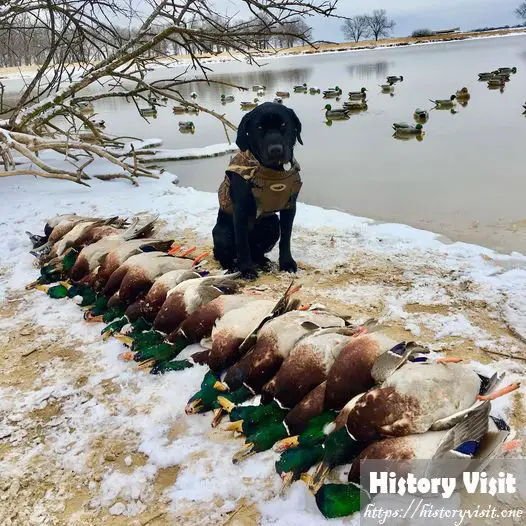
Understanding the migratory patterns and behaviors of waterfowl is essential for successful duck hunting in Kansas. These patterns are influenced by factors such as weather conditions, food availability, and breeding instincts. Here’s an overview of migratory patterns and behaviors common among waterfowl species hunted in Kansas:
1. Fall Migration
Timing:
- Fall migration typically begins in late summer or early fall, as days shorten and temperatures drop.
- Some species, such as Blue-winged Teal and Northern Pintails, migrate earlier than others, arriving in Kansas as early as August or September.
- Peak migration periods vary depending on weather conditions but often occur in October and November.
Routes:
- Waterfowl follow established migration routes known as flyways, with Kansas situated within the Central Flyway.
- Birds migrate southward from their breeding grounds in the northern United States and Canada to wintering areas in the southern United States, Mexico, and beyond.
Behaviors:
- During fall migration, waterfowl exhibit increased activity and movement as they travel to warmer wintering grounds.
- Birds may form large flocks, particularly during migration stopovers at key habitats such as wetlands, lakes, and reservoirs.
- Migrating ducks often feed voraciously to build up energy reserves for the long journey ahead, making them more susceptible to decoying and hunting pressure.
2. Wintering Period
Habitat Selection:
- Once in their wintering areas, waterfowl seek out suitable habitats with abundant food resources, open water, and shelter from harsh weather conditions.
- Wetlands, rivers, lakes, and agricultural fields provide essential wintering habitats for ducks in Kansas.
Feeding Behaviors:
- Ducks spend much of their time feeding on a variety of foods, including aquatic plants, seeds, grains, and invertebrates.
- Preferred feeding areas may change throughout the winter as food availability fluctuates and environmental conditions shift.
3. Spring Migration
Timing:
- Spring migration typically begins in late winter or early spring as days lengthen and temperatures rise.
- Waterfowl gradually return northward to their breeding grounds, with migration peaking in March and April.
Behaviors:
- Spring migration is less conspicuous than fall migration, with birds often traveling in smaller groups and over longer periods.
- Migrating ducks may stop to rest and feed at staging areas along their journey, particularly in regions with suitable wetland habitats.
4. Breeding Season
Nesting Behaviors:
- Once at their breeding grounds, waterfowl establish territories, select mates, and build nests in wetland habitats such as marshes, ponds, and prairie potholes.
- Females lay eggs and incubate them until they hatch, with the timing of nesting influenced by factors such as weather conditions and food availability.
Essential gear for duck hunting.

Duck hunting requires specialized gear to ensure comfort, safety, and success in the field. Here’s a comprehensive list of essential gear for duck hunting in Kansas:
1. Shotgun
- Choose a reliable shotgun chambered for 12 or 20 gauge, suitable for shooting non-toxic shot.
- Opt for a shotgun with a weather-resistant finish to withstand wet conditions.
2. Ammunition
- Use non-toxic shotgun shells approved for waterfowl hunting, such as steel, bismuth, or tungsten.
- Carry a variety of shot sizes to adapt to different hunting situations and species preferences.
3. Duck Decoys
- Invest in a diverse spread of duck decoys, including mallards, pintails, teal, and other common species found in Kansas.
- Consider motion decoys or remote-controlled decoys to add realism to your spread.
4. Calls
- Carry a selection of duck calls, including mallard calls, pintail whistles, and teal calls, to mimic the sounds of different duck species.
- Practice using calls to create realistic duck vocalizations and attract birds to your decoy spread.
5. Camouflage Clothing
- Wear camouflage clothing designed for waterfowl hunting to blend into the natural environment.
- Choose insulated clothing for cold weather hunts and lightweight, breathable options for warmer days.
6. Waders
- Invest in high-quality chest or hip waders to stay dry while setting decoys, retrieving downed birds, and navigating wetland habitats.
7. Hunting Blind
- Set up a portable or permanent hunting blind to conceal yourself from ducks while waiting for shooting opportunities.
- Camouflage the blind with natural vegetation for added concealment.
8. Duck Strap or Game Carrier
- Carry a duck strap or game carrier to transport harvested birds from the field to your vehicle.
- Choose a durable, adjustable strap with enough loops to accommodate multiple birds.
9. Safety Equipment
- Wear a personal flotation device (PFD) or float coat when hunting from boats or in deep water.
- Carry a whistle or signaling device for emergencies, and ensure you have a means of communication such as a cell phone or two-way radio.
10. Hunting License and Duck Stamp
- Obtain the necessary state hunting license, state waterfowl permit, and federal migratory bird hunting and conservation stamp (duck stamp) before hunting.
- Ensure all required licenses and permits are valid and readily accessible while in the field.
11. First Aid Kit
- Pack a compact first aid kit with essential supplies for treating minor injuries, cuts, or abrasions sustained during hunting activities.
12. Field-Dressing Supplies
- Carry a field-dressing kit with a sharp knife, game shears, and gloves for cleaning and processing harvested birds in the field.
13. Water and Snacks
- Stay hydrated and energized during long hunts by bringing water and high-energy snacks such as granola bars or trail mix.
14. Navigation Tools
- Carry a GPS device or compass to navigate unfamiliar hunting areas, especially in remote or densely vegetated wetlands.
15. Weather Gear
- Pack appropriate clothing layers, rain gear, and cold weather accessories to stay comfortable in changing weather conditions.
Popular hunting techniques (e.g., decoying, calling).
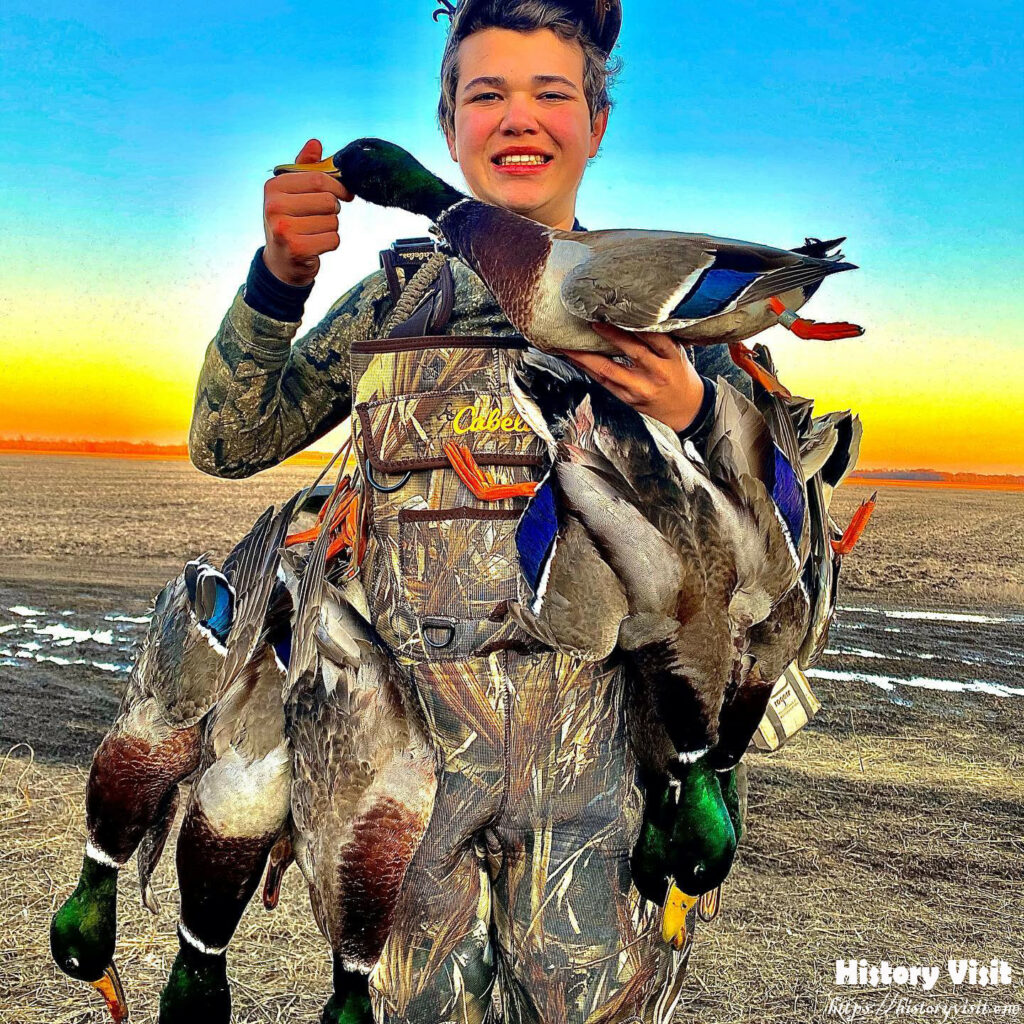
Duck hunting in Kansas employs various techniques to attract and harvest waterfowl effectively. Here are some popular hunting techniques used by hunters in the state:
1. Decoying
- Description: Decoying involves setting out a spread of duck decoys on the water or in fields to simulate a natural feeding or resting flock.
- Strategy: Arrange decoys in realistic configurations, with attention to species diversity, spacing, and wind direction. Movement decoys, such as spinning-wing decoys or fluttering decoys, can enhance the effectiveness of the spread.
2. Calling
- Description: Calling is the use of duck calls to mimic the vocalizations of live ducks, including quacks, feeding calls, and greeting calls.
- Strategy: Practice using duck calls to produce realistic sounds that attract ducks to your decoy spread. Start with simple quacks and work up to more complex calls as you gain proficiency. Use calls sparingly and pay attention to the response of nearby ducks.
3. Pass Shooting
- Description: Pass shooting involves positioning yourself along a flyway or migration route and shooting ducks as they fly past.
- Strategy: Choose strategic locations along waterways, open fields, or natural funnels where ducks are likely to fly within range. Concealment and scouting are essential for success in pass shooting.
4. Jump Shooting
- Description: Jump shooting involves flushing ducks from their resting or feeding areas and shooting them as they take flight.
- Strategy: Move quietly and stealthily through wetland habitats, using natural cover to conceal your approach. Be prepared for quick shots as ducks flush from cover.
5. Backwater Hunting
- Description: Backwater hunting takes place in secluded areas such as beaver ponds, flooded timber, or backwaters of rivers and lakes.
- Strategy: Use small boats or waders to access remote backwater areas where ducks seek refuge. Set up decoys and blinds in hidden locations to intercept passing birds.
6. Dog Retrieval
- Description: Hunting with a well-trained retriever dog enhances efficiency and retrieves downed birds from the water or dense vegetation.
- Strategy: Train your dog to retrieve ducks reliably and to remain steady in the blind or boat until sent to retrieve. Use hand signals and whistle commands to direct the dog during retrieves.
7. Layout Hunting
- Description: Layout hunting involves using layout blinds or boats to conceal hunters while targeting ducks on the water’s surface.
- Strategy: Set up layout blinds or boats in areas frequented by ducks, such as feeding or resting areas. Blend blinds with natural vegetation and use calling to draw ducks within shooting range.
8. Marsh Hunting
- Description: Marsh hunting takes place in shallow marshes, wetlands, and sloughs where ducks congregate to feed, rest, and breed.
- Strategy: Use small boats or waders to access marshy areas and set up decoys and blinds in strategic locations. Pay attention to wind direction and water depth when positioning decoys.
9. Puddle Duck Hunting
- Description: Puddle duck hunting targets dabbling ducks that feed primarily in shallow water, such as Mallards, Gadwalls, and Teal.
- Strategy: Focus on shallow wetlands, ponds, flooded fields, and agricultural areas where puddle ducks feed and rest. Use decoys and calling techniques tailored to attract these species.
Environmental and weather-related challenges.
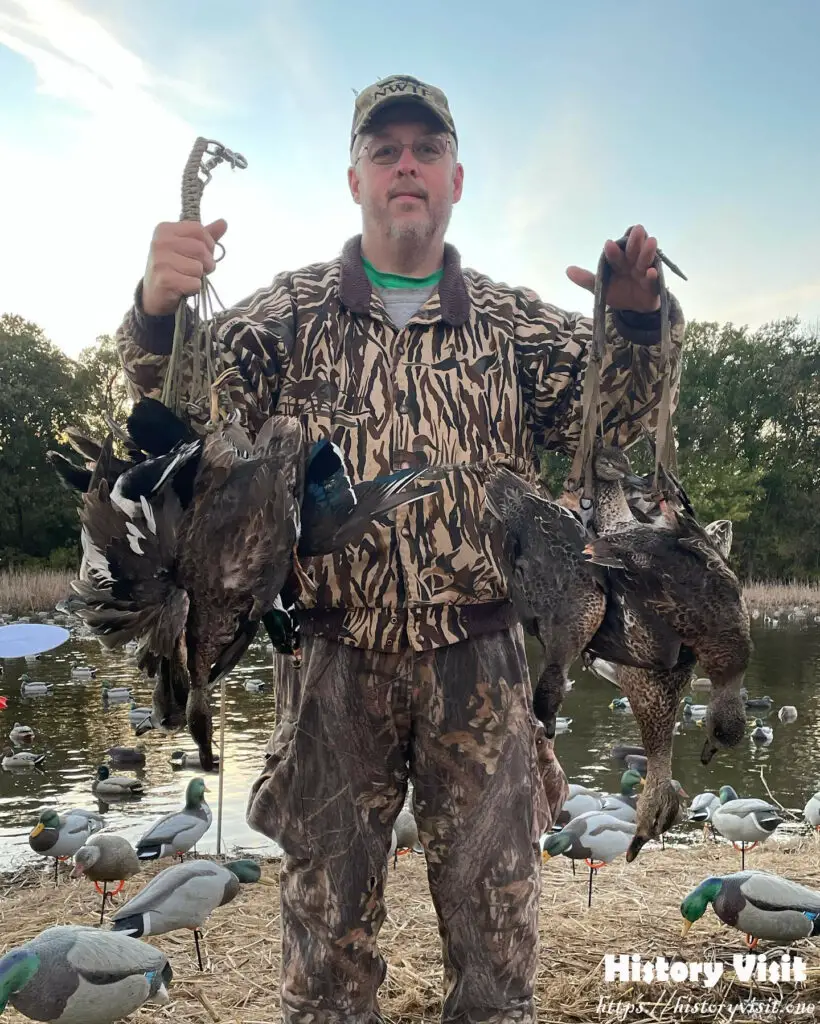
Duck hunting in Kansas presents various environmental and weather-related challenges that hunters must navigate to ensure safety and success in the field. Here are some common challenges faced by duck hunters:
1. Fluctuating Water Levels
- Description: Wetland habitats in Kansas are subject to fluctuations in water levels due to precipitation, river flow, and human water management activities.
- Challenge: Changing water levels can alter duck behavior and habitat availability, requiring hunters to adapt their hunting strategies accordingly. Shallow wetlands may dry up during periods of drought, while flooding can inundate hunting areas and disperse ducks.
2. Weather Extremes
- Description: Kansas experiences a wide range of weather extremes, including hot summers, cold winters, severe storms, and rapid temperature fluctuations.
- Challenge: Extreme weather conditions can impact duck behavior, hunting conditions, and hunter safety. High temperatures and drought can reduce wetland habitat quality and waterfowl abundance, while freezing temperatures and ice can limit access to hunting areas and affect decoy spread effectiveness.
3. Wind Patterns
- Description: Kansas is known for its variable wind patterns, with prevailing winds influenced by weather systems, topography, and seasonal changes.
- Challenge: Wind direction and intensity can significantly affect duck movement, decoy spread placement, and hunting success. Hunters must carefully consider wind direction when selecting hunting locations, setting up blinds, and positioning decoys to maximize their effectiveness.
4. Vegetation Growth
- Description: Wetland vegetation in Kansas undergoes seasonal growth cycles, with dense vegetation providing cover and food for ducks during the hunting season.
- Challenge: Thick vegetation can obstruct visibility, conceal ducks, and impede boat access in hunting areas. Hunters may need to clear shooting lanes, trim vegetation around blinds, and adjust decoy spread placement to improve shooting opportunities and decoy visibility.
5. Hunting Pressure
- Description: Popular hunting areas in Kansas may experience high hunting pressure during peak migration periods, weekends, and holidays.
- Challenge: Increased hunting pressure can educate ducks, making them wary of decoys, calls, and blinds. Hunters may need to seek out less-pressured hunting areas, adjust hunting times to avoid crowds, and employ alternative hunting techniques to attract educated birds.
6. Habitat Degradation
- Description: Wetland habitat degradation, caused by factors such as agricultural runoff, invasive species, and habitat loss, can impact waterfowl populations and hunting opportunities.
- Challenge: Degraded habitats may have reduced food availability, water quality, and nesting habitat for ducks, affecting their overall abundance and distribution. Hunters can support habitat conservation efforts, participate in wetland restoration projects, and advocate for responsible land management practices to address habitat degradation challenges.
Safety considerations and best practices.

Safety is paramount in duck hunting to ensure the well-being of hunters and their companions. Here are essential safety considerations and best practices for duck hunting in Kansas:
1. Firearms Safety
- Treat every firearm as if it is loaded, and always keep the muzzle pointed in a safe direction.
- Keep your finger off the trigger until ready to shoot, and only put your finger on the trigger when you’re prepared to fire.
- Know your target and what lies beyond it to avoid accidental shootings.
2. Boat Safety
- Wear a personal flotation device (PFD) at all times while in a boat, especially in rough water or adverse weather conditions.
- Ensure your boat is in good condition, properly equipped with safety gear, and adequately maintained.
- Avoid overloading the boat with gear or passengers, as this can affect stability and maneuverability.
3. Wading Safety
- Use appropriate waders and footwear with good traction to prevent slips and falls in wetland environments.
- Test water depth and footing before wading into unfamiliar areas, and be cautious of hidden hazards such as submerged obstacles or deep mud.
4. Weather Awareness
- Stay informed about weather forecasts and potential hazards such as storms, lightning, and extreme temperatures.
- Plan your hunting trips accordingly, and be prepared to adjust or cancel outings in response to adverse weather conditions.
5. Communication
- Establish a communication plan with hunting companions, including designated meeting points and check-in times.
- Carry a cell phone or two-way radio for emergencies, and ensure devices are fully charged and protected from water damage.
6. Blind Safety
- Construct or set up hunting blinds with stability and durability in mind, using sturdy materials and secure anchoring methods.
- Avoid overcrowding blinds with too many hunters or gear, as this can compromise safety and comfort.
7. Field Dressing Safety
- Use sharp, properly maintained knives and cutting tools for field dressing and processing harvested game.
- Exercise caution to avoid accidental cuts or punctures, and handle knives responsibly to prevent injuries.
8. Hunter Education
- Complete a certified hunter education course to learn essential safety principles, firearm handling skills, and hunting regulations.
- Refresh your knowledge regularly and stay informed about changes in hunting laws and safety guidelines.
9. Alcohol and Drug Use
- Avoid consuming alcohol or drugs before or during hunting trips, as impairment can impair judgment, coordination, and decision-making.
- Stay sober and alert to ensure safety for yourself and others in the hunting party.
10. Respect for Wildlife
- Treat wildlife with respect and ethical consideration, avoiding unnecessary harassment or disturbance.
- Follow regulations and best practices for fair chase hunting, and prioritize the welfare of game animals and their habitats.
Recap of the importance of duck hunting in Kansas.

Duck hunting holds significant importance in Kansas, both culturally and ecologically. Here’s a recap of why duck hunting matters in the state:
1. Cultural Tradition
- Duck hunting is deeply ingrained in the cultural fabric of Kansas, with a rich history dating back generations.
- Many families and communities in Kansas have strong traditions of duck hunting, passing down skills, knowledge, and camaraderie from one generation to the next.
2. Economic Impact
- Duck hunting contributes to the state’s economy through expenditures on licenses, permits, gear, lodging, and related services.
- The influx of hunters during the duck hunting season provides a boost to local businesses, including restaurants, hotels, gas stations, and sporting goods stores.
3. Conservation Funding
- Revenue from hunting licenses, permits, and the federal migratory bird hunting and conservation stamp (duck stamp) supports vital conservation efforts in Kansas.
- Funds generated from duck hunting directly contribute to wetland restoration, habitat enhancement, wildlife research, and other conservation initiatives benefiting waterfowl and their habitats.
4. Wildlife Management
- Duck hunting plays a crucial role in wildlife management by helping regulate waterfowl populations and minimize overpopulation issues.
- Harvest data collected from hunters provides valuable information for monitoring waterfowl populations, setting hunting regulations, and making informed management decisions.
5. Habitat Preservation
- Duck hunters are passionate advocates for wetland conservation and habitat preservation in Kansas.
- Through participation in habitat restoration projects, volunteer efforts, and advocacy, hunters contribute to the protection and enhancement of wetland ecosystems that support waterfowl and countless other species.
6. Outdoor Recreation
- Duck hunting provides an opportunity for outdoor enthusiasts to connect with nature, experience the beauty of Kansas wetlands, and enjoy the thrill of the hunt.
- Hunting fosters appreciation for the natural world and encourages responsible stewardship of natural resources among participants.
Future outlook and conservation efforts.

The future outlook for duck hunting in Kansas depends on continued conservation efforts, adaptive management strategies, and proactive stewardship of wetland habitats. Here’s an overview of key considerations and conservation efforts to shape the future of duck hunting in the state:
1. Habitat Conservation
- Wetland Restoration: Prioritize wetland restoration projects to enhance habitat quality and increase waterfowl breeding, nesting, and foraging opportunities.
- Land Protection: Secure critical wetland habitats through land acquisition, conservation easements, and partnerships with landowners to safeguard important waterfowl habitats from development and degradation.
- Vegetation Management: Implement habitat management practices such as prescribed burning, invasive species control, and vegetation management to maintain diverse and productive wetland ecosystems.
2. Sustainable Harvest Management
- Population Monitoring: Conduct comprehensive surveys and monitoring programs to assess waterfowl populations, breeding success, migration patterns, and habitat use in Kansas.
- Regulatory Framework: Establish science-based hunting regulations and harvest strategies that balance waterfowl conservation goals with sustainable hunting opportunities for hunters.
- Adaptive Management: Utilize adaptive management principles to adjust hunting regulations and management actions based on changing environmental conditions, population trends, and stakeholder input.
3. Research and Monitoring
- Research Initiatives: Invest in research projects and collaborative studies to improve understanding of waterfowl ecology, behavior, and habitat requirements in Kansas.
- Technological Advances: Harness advances in technology, including satellite telemetry, GPS tracking, and remote sensing, to collect data on waterfowl movements, habitat use, and population dynamics.
- Public Engagement: Engage hunters, conservation organizations, researchers, and the public in citizen science initiatives, data collection efforts, and habitat monitoring programs to enhance knowledge and stewardship of waterfowl resources.
4. Education and Outreach
- Hunter Education: Provide hunter education and outreach programs to promote ethical hunting practices, firearm safety, and conservation ethics among waterfowl hunters in Kansas.
- Public Awareness: Increase public awareness and appreciation for wetland conservation, waterfowl habitat importance, and the role of hunters as conservation stewards through outreach campaigns, educational materials, and community events.
5. Collaborative Partnerships
- Partnership Development: Foster collaborative partnerships among government agencies, non-profit organizations, private landowners, and the hunting community to coordinate conservation efforts, leverage resources, and maximize conservation outcomes.
- Stakeholder Engagement: Involve diverse stakeholders in conservation planning, decision-making processes, and habitat management initiatives to ensure broad support and effective implementation of conservation actions.



I always use to rewad paragraph in news papers but now
as I am a user of net therefore from now I am using net for articles or reviews,
thanks